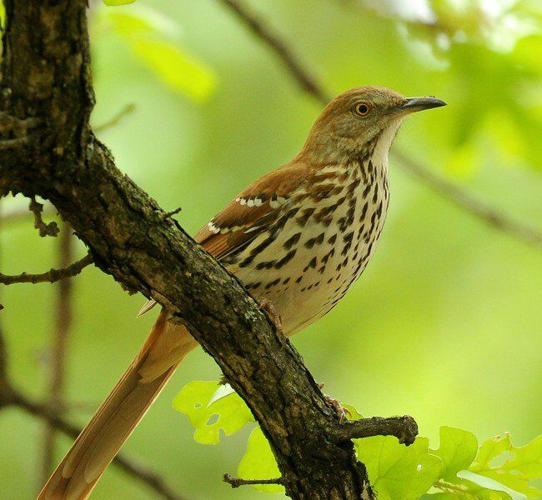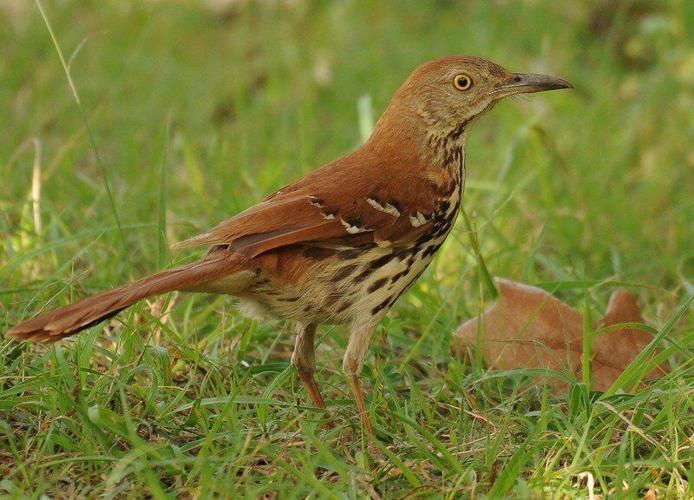Reclusive, secretive and ground-dwelling can all be used to describe the brown thrasher, this week’s featured creature.
I am revisiting these birds as I've had the pleasure of seeing them quite a few times since the beginning of the new year.
At my feeders, I had rare visits from one for a few days during the recent severe winter weather, when deep snow and sub-zero temperatures wreaked havoc on wildlife.
Some of the birds most affected by the snow were insect-eaters, which couldn't reach the ground to search for prey. Sadly, there were many reports of bluebirds, yellow-rumped warblers and phoebes having perished during the storm.
During that time, I continued to remove snow in a large area around my feeders, which allowed many birds to access the ground in search of seed and insects.
Three species that don't often visit my feeders -- the brown thrasher, American robin and northern flicker -- did so during that time.
While the brown thrasher typically eats insects, it will also consume nuts and seeds, which no doubt helps during severe winter weather.
I observed that the brown thrasher consumed loose seed and suet, while the robin ate seed and the flicker took advantage of the somewhat bare ground to probe for insects.
Although brown thrashers prefer to stay mostly out of sight, it’s not impossible to see them venturing out into the open in search of food.
The brown thrasher’s main habitat is thick undergrowth and it’s right at home in dense thickets, hedgerows, forest edges, briar patches and residential bushes and shrubs.
They get their name from the way they use their strong beaks to thrash about on the ground in leaf litter in search of food. The act of tossing leaves and twigs about can make a lot of noise. In fact, they are often heard before they are seen — at least in my case.
The brown thrasher, while on the ground searching for food, will hop about turning in different directions constantly watching for predators.
Males will sometimes perch at the tops of trees to sing during the spring months.
Like mockingbirds, brown thrashers are able to imitate the calls and songs of other birds. Some bird experts believe the brown thrasher’s voice is richer, fuller and more melodious than that of the mockingbird.
According to the Cornell Lab of Ornithology, brown thrashers can sing more than 1,100 different song types and include imitations of other birds.
According to Bird Watcher’s Digest, the spring arrival of brown thrashers in its northern breeding range is considered by many old-time farmers to be a signal that it’s time to plant certain crops, particularly potatoes.
Appearance
Brown thrashers are good-sized birds at about 11 to 12 inches from tail tip to the end of the beak. They are slightly larger than northern mockingbirds, which they are related to. Both are in the family Mimidae.
Brown thrashers are a bright rufous above and white underneath, streaked with brown (see photo). They have long thick legs and long tails, which they often hold up slightly, like wrens. They have bright golden eyes. The brown thrasher’s thick beak is slightly downcurved.
However, I have observed other types of thrashers in different parts of the country whose beaks make the brown thrasher’s look downright straight.
The curve-billed thrasher, for instance, is one. However, the curve-billed thrasher’s range covers west and southern Texas, the eastern half of New Mexico and a good portion of Mexico as well. A small portion of its range is located in southwestern Oklahoma.
Range
The brown thrasher is the only thrasher found in eastern states. The bird’s permanent range covers the southern two-thirds of Oklahoma, east through Arkansas on to Georgia and North Carolina, south to Florida, and then east to Texas. During the nesting season, its range triples in size and runs from southeast Texas northwest to British Columbia, Canada, then east to Maine.
Nesting
Brown thrashers are monogamous during the breeding season.
However, according to the Cornell Lab of Ornithology, brown thrashers breed in such dense vegetation, little is known of their courtship.
Females lay two to six eggs. Incubation will last from 10 days to two weeks. Both parents feed nestlings, which fledge quickly at about the same time period as incubation. Pairs may raise a second brood in a nesting season.
Brown thrashers are fiercely territorial and will attack many predators that get too close to the nest, according to the Cornell Lab of Ornithology.
Food
Brown thrashers eat mostly insects such as grasshoppers, beetles, worms, grubs, wasps, cicadas and caterpillars. They will also eat nuts, acorns, seeds and berries.
As well as thrashing about leaf litter, the brown thrasher will also use its beak to dig shallow holes in the ground in search of food. I’ve observed them doing this amongst shrubs near my home.
They will visit feeders. However, I believe the best way to attract brown
thrashers may be with a clean birdbath or a water feature. The Cornell Lab of Ornithology reports brown thrashers will visit feeders if food is offered, but there is a better chance they will visit if a dense cover is close by. Residents can also attract them by planting shrubs that produce berries.
In winter, brown thrashers occasionally visit my feeding stations and search the ground for seed, along with the juncos and sparrows. I’ve seen video footage of people in residential areas hand-feeding them raw, unshelled peanuts. So, I guess they eat peanuts too.
Odds and Ends
- The brown thrasher is the state bird of Georgia.
- The Cornell Lab reports that the brown thrasher is an aggressive defender of its nest, and is known to strike people and dogs hard enough to draw blood.
(Editor's Note: Randy Mitchell is a freelance writer and photographer. He has been an avid birdwatcher, nature enthusiast and photographer for more than 40 years. Reach him at rnw@usa.com.)



















Commented
Sorry, there are no recent results for popular commented articles.